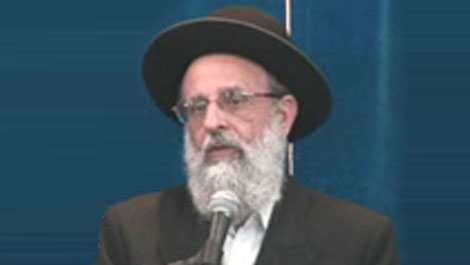Beit Midrash
- Sections
- Chemdat Yamim
- Bemare Habazak - Rabbis Questions
From what I have learned, our standard washing cups hold much more water than is needed for netilat yadayim. We in Israel certainly cannot afford to waste water. How much water must the cup hold, and how much of that must we pour over each hand?
Answer: There is a huge difference between the basic halacha and the practical application in this matter, and it is important to try arrive at a healthy perspective on the matter.
A cup used for netilat yadayim must hold and need not hold more than a revi’it (Shulchan Aruch, Orach Chayim 159:1). There is a well known machloket how much a revi’it is, with Rav Chayim Na’eh saying that it is 86 cubic centimeters (approximately 3 oz.) and the Chazon Ish saying that it is 150 cc. (app. 5 oz.), and there are other notable opinions in between. While this is an important machloket regarding such matters as Kiddush, it is usually not crucial regarding the cup for netilat yadayim, as it is hard to find a cup that is smaller than that.
Regarding the water, one does not have to use the entire revi’it. However, we will see that there are advantages to using a revi’it. When one pours less than a revi’it on the hands, the water becomes tameh, and if the water goes beyond the area that needs washing and then returns, it makes the hands tameh again (Shulchan Aruch, OC 162:2). This requires one to keep his hands facing up the whole time so that that which falls will not return. When a revi’it is used at one time, even if it is one revi’it for the two hands together, the water does not become tameh and the whole matter is not a problem (ibid.). According to most opinions (ibid.), when a revi’it is used, there is not even a need to wash the hands twice (see Mishna Berura 162:21, who explains the advantages of our minhag to wash twice anyway).
However, water must reach the entire area that needs to be washed at one time (Shulchan Aruch, ibid. 3). There is significant discussion as to how much of the hand this is. One opinion is that it is only the fingers, up to their connection to the palm of the hand. The other opinion, which is accepted practice under normal circumstances, is to wash the entire hand, until its connection to the wrist (ibid. 164:4). The Be’ur Halacha (ad loc.) advises that since one washes the entire hand, "it is very good to be careful not to use an exact amount, but he should wash with an abundance [of water], for if he uses exactly the amount of a revi’it, it is very likely that part of the hand will remain unwashed."
There is a famous story (which comes in many versions) of how Rav Yisrael Salanter was observed using a minimal amount of water for netilat yadayim because he did not want his preferred observance of the mitzva to come at the expense of someone else. This might support your suggestion that in our situation of limited water supply we should curtail our ritual use of water to the minimum amounts required. Under the correct circumstances (apparently Rav Salanter usually used a larger quantity) this is a very laudable approach. Using ridiculously large amounts of water (which, in public, usually means making people wait on line longer) is more likely a sign of OCD or ignorance than righteousness, but we should avoid being judgmental.
However, consider the following request for perspective, from the member of a household that puts great efforts into water conservation. Presumably, the average religious family expends less than 1% of its water usage on netilat yadayim. Therefore, cutting back on other uses by a mere .5% will save as much as cutting back on netilat yadayim by 50%. If one is already cutting everything to the maximum and wants to do so for netilat yadayim as well, his idealism is praiseworthy, and it is fine to concentrate on covering the whole hand with less water than most people need. But the great majority of our society, who use water with less idealism, should not make a special issue of water conversation regarding moderate use of water for netilat yadayim.

Bemare Habazak - Rabbis Questions (626)
Various Rabbis
29 - minyan
30 - netilat yadayim
31 - Why Can’t Women Blow the Shofar for Men?
Load More

Ask the Rabbi: Rubbing Cream on Someone who Accepted Shabbat
Rabbi Daniel Mann | Cheshvan 5786

Ask the Rabbi: Kohen Who Has Trouble Standing
Rabbi Daniel Mann | Cheshvan 5786

Ask the Rabbi: Transporting Children before or after Shacharit?
Rabbi Daniel Mann | Kislev 5786

























